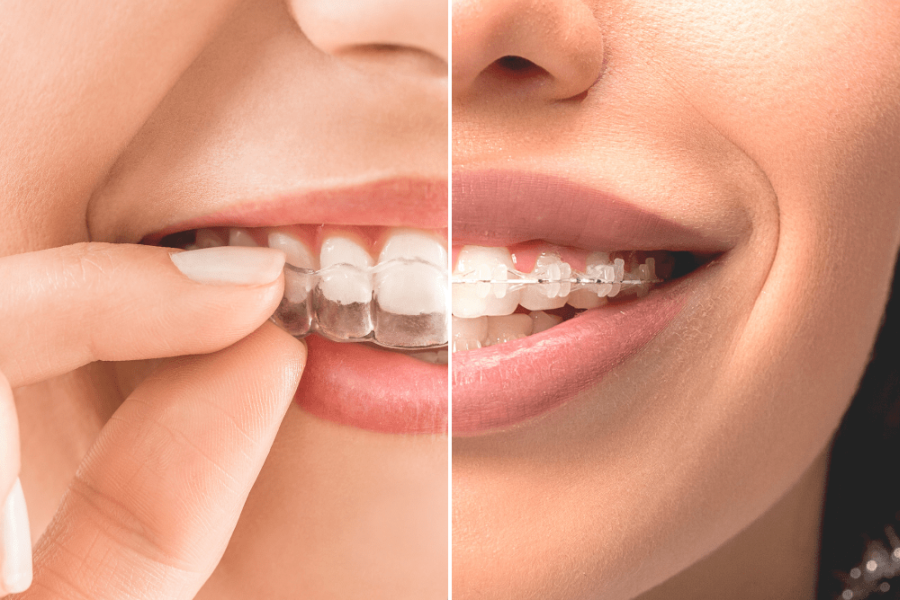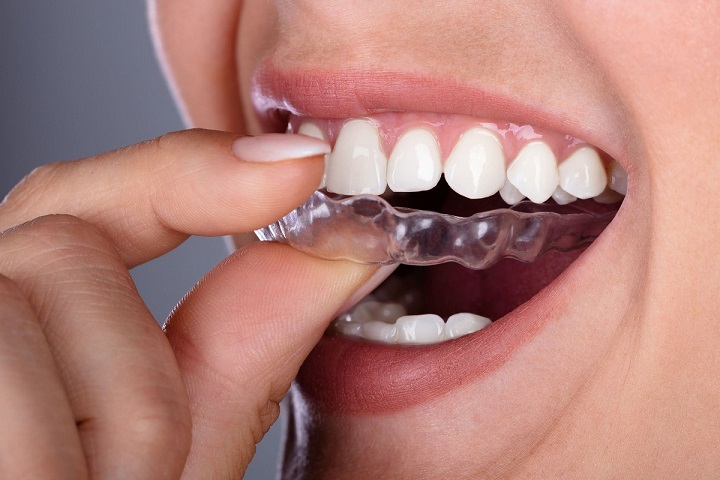Ever wished your smile could be a little straighter, a touch more confident? You’re not alone! Many people dream of having a smile they love to show off. Luckily, modern dentistry offers two fantastic options to achieve that dream smile: aligners and braces.
Both aligners and braces can straighten your teeth, but they work in slightly different ways. This blog post will guide you through the world of teeth straightening, explaining how aligners and braces function, their pros and cons, and how to choose the best option for you. Let’s explore your options and get you on the path to a smile you can’t wait to share.
Understanding Teeth Straightening: Why a Straighter Smile Matters
Teeth that are crowded, spaced out, or maybe even overlapping are not just a cosmetic concern. A branch of dentistry called orthodontics focuses on correcting these issues using tools like aligners and braces.
So, why is a straighter smile important? Well, beyond the confidence boost it brings, properly aligned teeth offer several benefits:
- Improved Oral Health: Straight teeth are easier to clean, reducing the risk of cavities and gum disease.
- Better Chewing: Properly aligned teeth can improve your chewing function, making it easier to enjoy your favorite foods.
- Speaking Clearly: Misaligned teeth can sometimes affect speech. Straightening them can improve your pronunciation.
- Confidence and Self-Esteem: A smile you love can work wonders for your confidence and self-esteem, making you feel more comfortable in social situations.
If you’re considering teeth straightening, the next step is understanding the two main options: aligners and braces. Let’s dive into how each one works and the unique advantages they offer.
Aligners: The Discreet Choice for a Straighter Smile
Aligners offer a wonderful option for cosmetic dentistry. Do you want to straighten your teeth without anyone noticing? Aligners can do it for you! They are clear, removable trays that fit properly over your teeth. They work by gently applying pressure, slowly shifting your teeth into the desired position over time.
So, how does aligner treatment typically work? First, you’ll schedule a consultation with your dentist or orthodontist. They’ll examine your teeth and discuss your goals. If aligners seem like a good fit for you, they’ll likely take digital scans of your teeth to create a precise 3D model. This model is used to design a series of custom-made aligners, each slightly different from the last.
Here’s the exciting part: you’ll receive a set of aligners to wear at home! Typically, you’ll wear each aligner for a specific period (often around two weeks) before switching to the next set in the series. This gradual approach ensures comfortable and controlled tooth movement.
One of the biggest advantages of aligners is their comfort. Unlike traditional braces, they’re made of smooth plastic, eliminating the irritation that brackets and wires can cause. Plus, the best part? Aligners are removable! This means you can take them out for eating, drinking (except water), and brushing your teeth, making maintaining good oral hygiene a breeze. And let’s not forget the invisibility factor! Aligners are practically transparent, so most people won’t even notice you’re wearing them.
However, aligners do require some commitment. Consistent wear is crucial for successful treatment. If you don’t wear them for the recommended time each day, your progress could be delayed. Additionally, aligners may not be suitable for all cases of misalignment. More complex orthodontic issues might require the precise control offered by traditional braces.
There are several popular aligner brands available. If you’re interested in learning more about specific aligner brands, your dentist or orthodontist can provide more information.
Braces: The Traditional Path to a Straighter Smile
For many people, braces remind unpleasant images of childhood and metal tracks across teeth. However, braces remain a highly effective and popular method for achieving a straighter smile. They work by using a system of brackets bonded directly to the front of each tooth. These brackets are then connected by thin wires that exert a gentle, continuous force. Over time, this pressure gradually guides your teeth into their ideal positions.
The braces treatment process typically starts with a consultation with your dentist or orthodontist. During this visit, they’ll conduct a thorough examination of your teeth and discuss your desired outcome. If braces appear to be the most suitable option for your case, they’ll likely take impressions of your teeth. These impressions are used to create custom-made brackets and wires specifically designed for your unique smile.
One of the biggest advantages of braces is their effectiveness for a wide range of misalignment issues. Unlike some alternatives, braces offer a significant degree of control. Your dentist or orthodontist can precisely adjust the pressure applied to each tooth through the wires, allowing for targeted movement. This level of control makes braces particularly well-suited for addressing more complex orthodontic cases.
However, it’s important to consider some potential drawbacks of braces. Unlike removable aligners, braces are fixed to your teeth throughout treatment. While they come in various materials like clear or tooth-colored brackets, they are generally quite noticeable. This visibility might be a concern for some people who prefer a more discreet approach.
Additionally, braces may necessitate some adjustments to your diet. Sticky or hard foods can damage the brackets or wires, so you might need to temporarily avoid them. Finally, while generally comfortable, braces can cause some temporary discomfort during adjustments. These adjustments are typically needed every few weeks to maintain pressure and ensure progress.
There are different types of braces available, each with its own advantages. Metal braces are the most common and affordable option. Ceramic braces offer a more discreet appearance as the brackets blend in with the color of your teeth. Self-ligating braces use a special clip mechanism to hold the wire in place, potentially reducing the need for adjustments and associated discomfort. While these variations exist, the core function of applying controlled pressure to move teeth remains the same.
Ultimately, the choice between braces and aligners depends on your individual needs and preferences. In the next section, we’ll explore some key factors to consider when making this decision.
Choosing Between Aligners and Braces: The Perfect Smile Solution for You
Now that you’ve explored the worlds of aligners and braces, it’s time to decide which path leads to your perfect smile! Remember, a consultation with a dentist or orthodontist is the most important step. They can evaluate your unique situation, discuss your goals, and recommend the ideal treatment approach.
Here’s a breakdown of key factors to consider when choosing between aligners and braces:
- Removable vs. Fixed: Aligners shine with their removability for eating, drinking (except water), and brushing. This makes maintaining good oral hygiene a breeze. Braces, on the other hand, are fixed to your teeth throughout treatment, requiring some dietary adjustments to avoid damaging brackets or wires.
- Discreetness: If invisibility is your top priority, aligners are a clear winner. They’re practically transparent, so most people won’t even notice you’re wearing them. Braces, while offering clear or tooth-colored bracket options, are generally more noticeable.
- Treatment Time: Aligners typically have a shorter treatment time, especially for mild to moderate misalignment. However, the exact duration depends on the complexity of your case. Braces treatment times can vary as well, but they can sometimes be a bit longer than aligners.
- Cost: Aligners might have a slightly higher upfront cost compared to braces. However, the convenience and potentially shorter treatment time can make them a competitive option.
- Suitability for Different Cases: Aligners excel at treating mild to moderate misalignment. Braces, on the other hand, are the workhorses of orthodontics, effectively tackling even complex cases.
Beyond these factors, your lifestyle and personal preferences also play a role. If you have a busy schedule, the flexibility of removable aligners could be a major advantage. For those prioritizing discretion, clear braces might offer a suitable alternative. Ultimately, your comfort level and commitment to consistently wearing aligners as instructed are important considerations.
By openly discussing these factors with your dentist or orthodontist, you can confidently choose the path to your dream smile! They can provide personalized insights based on your specific needs and ensure you achieve the beautiful, healthy smile you deserve.
Conclusion
Unveiling a straighter, more confident smile is possible with both aligners and traditional braces. Each option offers unique advantages, and the best choice for you depends on your individual needs and preferences. Dentist @ False Creek, the best dentist in Vancouver, is here to guide you on your smile journey!
Our experienced team offers a comprehensive range of dental services, including extractions, gum disease treatment, sedation dentistry for anxiety-free procedures, family dentistry for patients of all ages, root canal therapy, apicoectomy, cosmetic dentistry procedures such as teeth whitening, dental veneers, dental bonding, and smile makeovers.
We can assess your specific situation, explain the benefits of both aligners and braces, and develop a personalized treatment plan tailored to achieve your dream smile. Don’t wait any longer to embrace the confidence that comes with a beautiful smile. Contact Dentist @ False Creek today and schedule your consultation!


